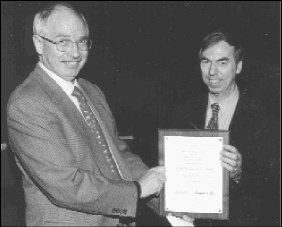
York's Borroughs Wellcome lecture: breaking new ground in medical science
By Sandra Guiry
"New Twist on Old Paradigms of Mitochondrial Evolution" was the title of the 1998-1999 Burroughs Wellcome Lecture held recently at York University.
York was honoured with one of only five Burroughs Wellcome Visiting Professorships in the Basic Medical Sciences awarded in Canada this year, with the nomination of Dr. Michael Gray as its visiting professor. The application to host the visiting professor was made through the Department of Biology on behalf of the University, and was successful because of the strong reputations of both Gray and the department. The award includes a $5,000 grant from the Burroughs Wellcome Fund to be used as an honorarium and to facilitate the individual honour with the professorship to deliver various lectures at York, and to interact with students and faculty.
Gray, an eminent Canadian scientist in the Department of Biochemistry at Dalhousie University, is a leader in the country in the study of molecular biology/
biochemistry and molecular evolutionary biology. As well as being a very productive researcher, Gray has served the life science community well in many capacities including Chair of the initial peer review committee for the Canadian Genome and Analysis Technology (CGAT) Program, and he is currently a director of Genome Canada. Among numerous honours and recognitions he is a Fellow of the Royal Society of Canada, a Fellow (Confederation Fellow) of the Evolutionary Biology Program of the Canadian Institute for Advanced Research, a recipient of the Boehringer Mannheim Canadian Prize of the Canadian Biochemical Society, and the first recipient of the Award of Merit, Canadian Society for Plant Molecular Biology.
Gray earned his BA and PhD at the University of Alberta, and completed post-doctoral studies at Stanford. He is the author of over 95 original publications.
Gray spent almost four full days on campus, from March 22-25, 1999. As well as presenting the Burroughs Wellcome Lecture, he presented a research seminar to the Department of Biology, lectured in a graduate class in nucleic acids, and met individually and in groups with many faculty, graduate and undergraduate students. It was a busy and productive few days.
Gray delivered the Burroughs Wellcome lecture, which highlighted current research in the area of mitochondrial evolution, to a packed audience in York's Senate Chamber, on March 24, 1999.
The lecture paid specific reference to answering the scientific question of how the mitochondrion originated. The traditionally favoured model called the serial endosymbiosis theory suggests "that mitochondria are the direct descendants of a bacterial endosymbiont that became established at an early stage in a nucleus-containing host cell," Gray said. "However, recent studies indicate that mitochondria arose in a common ancestor of all extant eukaryotes and raise the possibility that this organelle originated at essentially the same time as the nuclear component of the eukaryote cell rather than in a separate, subsequent event."
Much of the data on which ideas about mitochondrial origins and evolution are based come from large scale organelle genome sequencing projects to which Gray has contributed. Studies of mitochondrial DNA suggest mitochondrial ancestry can be traced to a single ancestor related to *-proteobacteria and genera such as Rickettsia, which are considered to be among the closest known eubacterial relatives of mitochrondia, Gray explained.
More genes have been found in the mitochondrial genome of Reclinomonas americana, first described in 1993, than in any other mitochondrial DNA characerized to date and this has provided an exceedingly important data set for addressing questions of mitochondrial origins. Reclinomonas americana is a heterotrophic flagellated protozoan that has been described as just "lying there sweeping in bacteria into its houghs." As such, it has been referred to as the "American couch potato," joked Gray.
"The quest for mitochondrial genomes even more ancestral than that of Reclinomonas americana continues in an effort to uncover even larger, more gene-rich mitochondrial DNAs."
The results of the work of Gray and his collaborators challenge the traditional serial endosymbiotic theory for the origin of mitochondria and suggest that mitochondria may have originated at the same time as the nucleus of a eukaryotic cell rather than in a separate, subsequent event.
Not only is the work described by Gray important to addressing questions about cellular evolution but mitochondria, as the power plant of the eukaryotic cell are crucial to a cell's function. Applications of research on mitochondria are important in addressing evolutionary questions and also feature prominently in learning how mitochondrial defects contribute to the pathogenesis of some human degene



